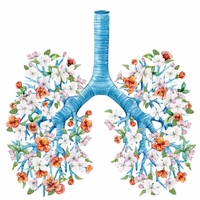
A recent study has found that lower serum levels of vitamins A, C, D, and α-tocopherol vitamin E are associated with higher respiratory morbidity and mortality (1).
Respiratory diseases such as chronic obstructive pulmonary disease (COPD) and asthma are now recognised as significant health problems due to their increased prevalence and mortality worldwide (2). Oxidative stress is well-documented to play a role in these respiratory diseases (3,4). The large surface area for gas exchange and profuse vascularisation makes the lungs susceptible to oxidative stress-mediated injury (5). Furthermore, inhalation of air pollutants or pathogens and the activation of macrophages and inflammatory cells in response to injury deplete endogenous antioxidant capacities (6,7).
Oxidative stress is a significant driving mechanism in the initiation and progression of COPD (8). It stimulates air inflammation and remodelling, accelerates lung ageing, causes DNA damage, and stimulates the formation of autoantibodies (3). In asthma, oxidative stress aggravates airway inflammation by activating transcription factors and pro-inflammatory mediators. Moreover, it enhances airway hyper-responsiveness and stimulates mucin secretion, both of which are associated with severe asthma (9). Influenza and other viruses invade host cells and generate oxidative stress, mediating tissue damage, inflammatory response, and cell apoptosis (10). Oxidative stress can increase disease severity and is a risk factor for severe illnesses such as pneumonia (11).
Antioxidant vitamins may ameliorate oxidative stress and pathogenesis of respiratory disease; however, study findings have been inconsistent mainly because many of these studies have relied on self-reported dietary intake of antioxidant vitamins rather than objectively measured serum vitamin levels (12,13,14,15).
Serum antioxidant levels
The current study utilised national survey data to evaluate whether lower serum concentrations of vitamins A, C, D (25-hydroxy-vitamin D (25-OHD)), and E (α- and γ-tocopherol isoforms) are associated with respiratory morbidity and mortality in the U.S. adult population. Data from over 34,000 participants involved in the 1988–1994 and 1999–2006 National Health and Nutrition Examination Survey (NHANES) was assessed. Vitamin supplementation and smoking were evaluated as potential effect modifiers.
The prevalence of vitamin A deficiency in the study was only 0.2%, and no association between serum vitamin A levels and respiratory morbidity were observed. However, lower levels of serum vitamin A were associated with increased mortality from chronic lower respiratory disease (CLRD) among participants who did not use vitamin supplements and among smokers.
Lower serum vitamin C increased the odds of wheeze and was associated with increased mortality from CLRD. The associations between serum vitamin C levels and respiratory morbidity and mortality were not modified by supplemental vitamin use or smoking. Vitamin C deficiency, defined using a clinically established threshold value of < 0.20 mg/dl, was associated with increased mortality from influenza/pneumonia.
Lower levels of serum 25-OHD were associated with respiratory mortality but not morbidity. Lower serum 25-OHD increased mortality from CLRD and influenza/pneumonia among smokers. Serum 25-OHD insufficiency (< 50 nmol/L) was also associated with increased mortality from influenza/pneumonia, increasing mortality risk two-fold.
Among smokers, lower serum α-tocopherol vitamin E increased the odds of wheeze and chronic bronchitis/emphysema. In contrast, lower serum γ-tocopherol levels were associated with lower odds of wheeze and chronic bronchitis/emphysema.
Mechanisms of action
Vitamins A, C, D and E can protect airways and lung tissue from oxidative damage and support respiratory health through various mechanisms.
Vitamin A exerts its antioxidant effects by neutralising free radicals and reducing lipid peroxidation (16). In addition, it is involved in the proliferation and maintenance of epithelial cells of the respiratory tract, which function as the front line of defence against pathogenic invasion (17). Vitamin A deficiency has been associated with histopathological changes within the respiratory tract that can disrupt the normal lung physiology and lead to severe tissue dysfunction and respiratory diseases (18).
Vitamin C, a water-soluble vitamin, is responsible for maintaining the antioxidant capacity in the aqueous phase by scavenging reactive oxygen species (ROS), while also regenerating cellular vitamin E from its oxidised form. Vitamin C is a potent antioxidant in airway surface liquid and protects the lungs by supporting epithelial barrier function, and innate and adaptive immune cell function (19,20).
Vitamin D exerts immunomodulatory effects and can inhibit pulmonary inflammatory responses while enhancing innate defence mechanisms against respiratory pathogens (21). In addition, vitamin D can reduce lipid peroxidation and act through the vitamin D receptor to reduce free radical production (22). It also plays an essential role in tissue remodelling and innate and adaptive immune responses in the lung (23,24).
Vitamin E is a free radical scavenger found in lipid membranes and extracellular lung fluids. It also has anti-inflammatory and immune-modulating effects (25). However, studies of vitamin E and respiratory health have shown conflicting results, possibly due to opposing inflammatory actions of different tocopherol isoforms on lung inflammation and disease (25,26,27).
Conclusion
These latest results indicate that lower serum antioxidant levels increase the risk of respiratory disease and mortality. The study also highlights the association between lower serum antioxidant levels, smoking and respiratory health. However, it is important to note that other factors such as air pollutants, occupational chemicals and dust, pathogens and aeroallergens might also impact antioxidant levels and respiratory outcomes.
The study results suggest that addressing the nutritional deficiency of these antioxidant vitamins through diet and supplementation is necessary to decrease the risk of respiratory disease and infection. Furthermore, given that respiratory diseases are significant causes of morbidity and mortality worldwide, future longitudinal studies and clinical trials are required to elucidate the role of antioxidant vitamins in respiratory health.




